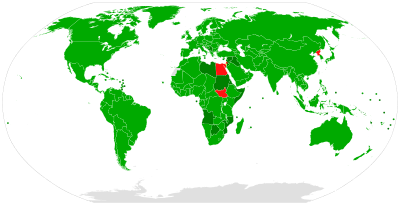Day of Remembrance for all Victims of Chemical Warfare
| Day of Remembrance for all Victims of Chemical Warfare | |
|---|---|
| Also called | Remembrance Day |
| Observed by | All UN Member States |
| Date | April 29 |
| Next time | 29 April 2017 |
| Frequency | annual |
| Related to | Chemical Weapons Convention |
The Day of Remembrance for all Victims of Chemical Warfare is an annual event held on April 29 as a "tribute to the victims of chemical warfare, as well as to reaffirm the commitment of the Organization for the Prohibition of Chemical Weapons (OPCW) to the elimination of the threat of chemical weapons, thereby promoting the goals of peace, security, and multilateralism."[1] It is officially recognised by the United Nations (UN) and has been celebrated since 2005. On the 2013 observance day, the UN Secretary-General Ban Ki-moon gave a speech where he stated:
On this Remembrance Day, I urge the international community to intensify efforts to rid the world of chemical weapons, along with all other weapons of mass destruction. Let us work together to bring all States under the Convention and promote its full implementation. This is how we can best honour past victims and liberate future generations from the threat of chemical weapons.[2]
History

On November 11, 2005, during the last day of the United Nations' Tenth Session of the Conference of the State Parties, the members of the UN officially recognised the Day of Remembrance for all Victims of Chemical Warfare, following a suggestion by Rogelio Pfirter, Director-General of the Secretariat. In addition, Pfirter's proposal to erect a monument at the Hague commemorating all victims of chemical warfare was approved. April 29 was chosen as the date for the event's celebration because the Chemical Weapons Convention entered into force on that day in 1997.[3]
Although the majority of the world has either given up or destroyed their stockpiles of chemical weapons as of 2013, several nations have yet to do so. Five of these, Angola, Burma, Egypt, Israel, and North Korea, have not ratified the Convention and are suspected to possess chemical weapons.[4][5] Syria is also known to possess a sizeable stockpile and Secretary-General Ban Ki-moon noted this in his 2013 speech, condemning the nation for its alleged exploitation of chemical weapons in its ongoing civil war.[6] On September 14, 2013 the United States and Russia announced in Geneva that they reached a deal whereby Syria would ratify the treaty and give up its chemical weapons.[7] The Syrian government has been cooperating and as of November 2013, all but one of Syria’s 23 publicly declared chemical weapon sites have been visited by international inspectors that are dismantling the Syrian chemical weapons program.[8]
References
- ↑ "Day of Remembrance for all Victims of Chemical Warfare". United Nations. Retrieved October 4, 2013.
- ↑ Ban, Ki-moon (April 29, 2013). "Message on the Day of Remembrance for All Victims of Chemical Warfare". United Nations Information Service Vienna. Retrieved November 10, 2013.
- ↑ "Report of the Tenth Session of the Conference of the State Parties" (PDF). United Nations. Retrieved October 4, 2013.
- ↑ "Convention on the Prohibition of the Development, Production, Stockpiling and Use of Chemical Weapons and on their Destruction". United Nations Office for Disarmament Affairs. Retrieved 2013-11-14.
- ↑ "States not Party to the Chemical Weapons Convention". Organisation for the Prohibition of Chemical Weapons. Retrieved 2013-11-14.
- ↑ "United Nations urges Syria to let in chemical weapons experts". NDTV. April 30, 2013.
- ↑ Solomon, John (2013-09-14). "US, Russia reach deal on Syria chemical weapons". Washington Times. Retrieved 31 October 2013.
- ↑ Stampler, Laura (Nov 7, 2013). "Inspectors Confirm Almost All Syria Chemical Weapons Sites". TIME Magazine. Retrieved November 10, 2013.